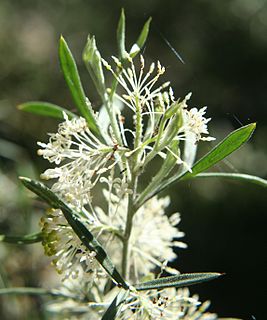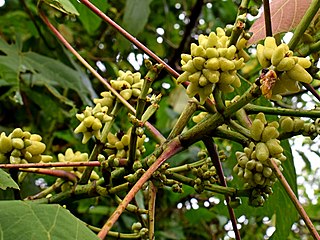
Asimina is a genus of small trees or shrubs described as a genus in 1763.
The Laginiopsidae are a taxonomic family of floating and swimming sea snails, sea slugs or sea angels, pelagic marine opisthobranch gastropod mollusks in the suborder Gymnosomata, the sea angels.

Asimina triloba, the American papaw, pawpaw, paw paw, or paw-paw, among many regional names, is a small deciduous tree native to the eastern United States and Canada, producing a large, yellowish-green to brown fruit. It belongs to the genus Asimina in the same plant family as the custard-apple, cherimoya, sweetsop, ylang-ylang, and soursop.

Grevillea triloba is a spreading shrub endemic to Western Australia, principally the Geraldton area. Its height usually ranges between 0.9 and 1.5 metres high. The flowers, which are sweet-scented, are usually white but pink flowering forms have been observed within the natural distribution. These are produced from early winter to mid spring. Its narrow leaves are three-lobed and each of the lobes terminates in a sharp point.

Rudbeckia triloba, the browneyed or brown-eyed susan, thin-leaved coneflower or three-leaved coneflower, is a species of flowering plant in the daisy family Asteraceae, native to the United States. It is often seen in old fields or along roadsides. It is also cultivated as an ornamental.

Utricularia triloba is a small annual, terrestrial carnivorous plant that belongs to the genus Utricularia. It is native to Central and South America and is found in the following countries: Argentina, Belize, Bolivia, Brazil, Colombia, French Guiana, Guyana, Paraguay, Peru, Suriname, and Venezuela.

Ipomoea triloba is a species of Ipomoea morning glory known by several common names, including littlebell and Aiea morning glory. It is native to the tropical Americas, but it is widespread in warm areas of the world, where it is an introduced species and often a noxious weed. This is a fast-growing, vining, annual herb producing long, thin stems with ivy-like, petioled, heart-shaped leaves 2.5–6 centimetres (0.98–2.36 in) long. The leaves sometimes, but not always, have three lobes. The vines produce tubular bell-shaped flowers, each about two centimeters long. They are quite variable in color, in shades of pink, red or lavender, with or without white markings.

Synaphea is a genus of small shrubs and is endemic to Western Australia. Synapheas have variably shaped leaves but consistently yellow flowers with an unusual pollination mechanism.

Anisodontea is a genus of flowering plants in the tribe Malveae of the mallow family Malvaceae. It comprises twenty-one species native to South Africa. Members of the genus typically bear toothed leaves with three or five palmate, uneven lobes. Members of the genus also typically bear flowers with a pubescent calyx, a five-petaled corolla streaked from the center and pink to magenta in color, and stamens with anthers of a dark color.

Patrinia is a genus of herbaceous plants in the honeysuckle family (Caprifoliaceae). There are about 17 species native to grassy mountain habitats in China, Siberia and Japan. These are unassuming clump-forming perennial plants having thin, erect stems with few leaves and bearing a terminal inflorescence with yellow or white flowers.
Paramordellana is a genus of beetles in the family Mordellidae, containing the following species:

Miersia is a plant genus in the Amaryllidaceae. All 5 known species are native to Chile and Bolivia.

Paramordellaria is a genus of tumbling flower beetles in the family Mordellidae. There are at least two described species in Paramordellaria.
Therippia is a genus of longhorn beetles of the subfamily Lamiinae, containing the following species:
Therippia triloba is a species of beetle in the family Cerambycidae. It was described by Francis Polkinghorne Pascoe in 1859, originally under the genus Cacia.
Pareuidella is a genus of delphacid planthoppers in the family Delphacidae. There are about five described species in Pareuidella.

Macaranga triloba is a species of plant in the family Euphorbiaceae. It is native to the tropical forests of southeastern Asia. It is a pioneer species, colonising recently cleared or burnt areas of the forest.
Pompholyx is a genus of rotifers belonging to the family Testudinellidae.
Grevillea pieroniae is a species of plant in the protea family that is endemic to Australia.










